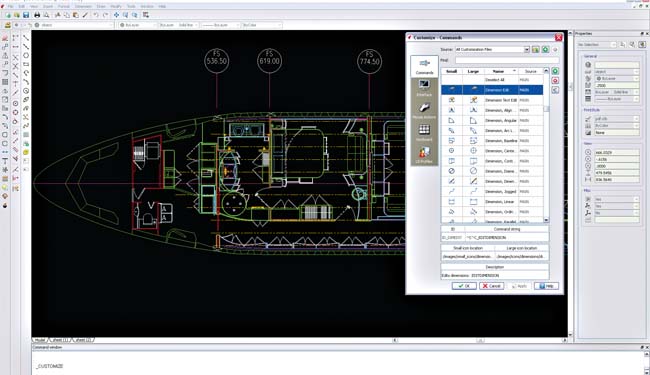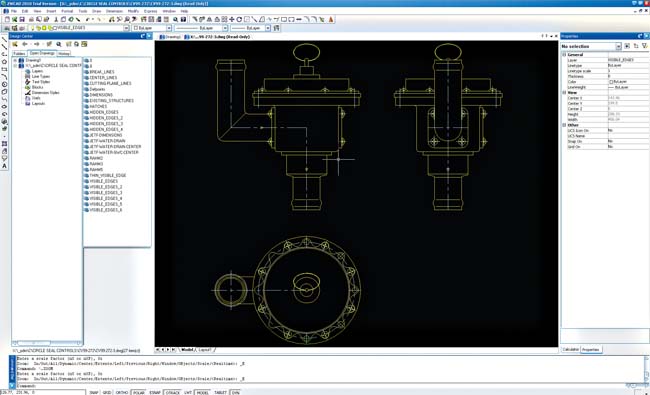Wallet-friendly 2D CAD
ARES, DoubleCAD and ZWCAD (and a newbie) are Autodesk competitors that are chomping at the AutoCAD installation base at every opportunity.
Latest News
September 1, 2010
By Josh Mings
You may not know it, but in the world of 2D design, you have a truckload of options for alternatives to Autodesk AutoCAD products. We’re not talking about cheap knockoffs either. These are full-featured, actively developed 2D CAD programs. While keeping the AutoCAD look and feel, they bring their own set of options and functionality, their own improvements on the original, and best of all, a price coming in so much lower, it would be criminal not to look into how they perform.
 ARES has a clean, simple interface and lots of options to easily customize the menus, toolbars, the mouse and more. |
ARES, DoubleCAD and ZWCAD claim to be better than AutoCAD. You’ll see it on their sites in headlines and comparisons, but are they better? Let’s take a look at these three very capable options in the space of wallet-friendly 2D CAD. We’ll even throw in a little twist at the end that’ll have you thinking about these options even more.
The (CAD) Clone Wars
To get a better understanding of what these programs can do, there’s a matter we should touch on briefly—where they all came from. Because all three claim to be alternatives to AutoCAD, there’s no doubt they draw the core of their inspiration from the program. Often, these programs are referred to as “AutoCAD clones” or “ARX clones,” ARX being the software development kit (SDK) that powers AutoCAD. However, all of these programs take their own path from the groundwork Autodesk laid with AutoCAD.
Here’s how it happened. In 1998, Visio formed the Open Design Alliance (ODA) to make the DWG format open and accessible. In 1999, Visio divested the IntelliCAD 2D drawing product, formed the IntelliCAD Technology Consortium (ITC) and the first DWG development platform was available.
 ZWCAD brings speed to the drawing environment, and sports a Design Center to access libraries and attributes in other open drawings. |
In 2002, the ODA introduced its own SDK called DWGDirect. There were now two DWG development platforms. Then, in 2006 the ITC, after distributing six versions, announced that version 7 would run completely on the ODA’s DWGDirect engine. Four years later, it has yet to be released.
The ODA, in 2010, renamed DWGDirect to Teigha for DWG files so as to encompass all the compatibility, operating systems and third-party components available through its newly established Teigha platform. But even before all of this, AutoCAD clones were being developed.
In 1993, Berlin-based Graebert, after being cut off as a third-party developer for AutoCAD by Autodesk, began development on its own platform. In early 2010, after five years of development, Graebert launched ARES, a platform with its own SDK that resides as a wrapper around the ODA SDK. Graebert, it should be pointed out, is also a founding member of the ODA.
DoubleCAD is from California-based IMSI/Design, makers of TurboCAD. DoubleCAD is built on the same TurboCAD platform, and uses DWG read/write functions from the ODA SDK. Interestingly, Mauritz Botha, DoubleCAD CTO and lead developer, is the current ODA chairman.
That leaves ZWCAD. ZWSoft, located in Guangzhou, China, launched ZWCAD in 2002. It uses the ITC version 6 code base and has developed its own SDK: ZRX. It wraps around the ODA dev platform while still accessing ITC code.
What to Expect
There is certainly a level of expectation when it comes to the capabilities a drafting program has. The first thing you’ll notice if you were to run all three at once is the start-up speed and interface of ARES. It’s fast and clean. It also has the smallest download at 41MB, where ZWCAD rings in at 139MB and DoubleCAD at 152MB.
They all provide the same basic set of functionality, from drawing tools and modifying tools to blocks, layers, templates and dimensions. However, each has ways of improving upon these standard tools. While none make an outright attempt to emulate the AutoCAD interface or the modern ribbon bar navigation (thank goodness), there’s enough similarity to make anyone familiar with AutoCAD feel comfortable with banging away at the command line or accessing commands via the toolbar.
More Info: > Price: • ZWCAD Standard: $499 • DoubleCAD XT Standard: Free • DraftSight Standard: Free |
All handle legacy DWG data relatively well, all the way back to AutoCAD 2.5 and up to AutoCAD 2009—with each having plans for 2010 support. Windows 7 support is also available for all three. Each company offers two versions, the standard edition being a stripped-down version of the professional edition. Let’s focus on the lower-priced standard editions and point out specifics that may interest you about the professional versions:
The Smooth: ARES
With ARES, you’re off and running. The program starts up quickly, has a clean user interface (UI) and provides all the familiarity of classic AutoCAD needed to start dropping draft lines and dimensions across the screen. Like AutoCAD, the display area provides model space and paper space to help divide up your workflow, but you also have the option to turn it off. The toolbars are similar enough to other drafting programs—and intuitive enough to figure out for those without 2D drafting experience.
What really stands out about the ARES interface, though, is the ability to customize it. If you need a new menu, simply right-click on the menus to bring up the customiza
ARES even has some 3D capability. You can view 3D, use lighting, shading and materials. AutoCAD LT can’t do that, but like AutoCAD LT, ARES doesn’t come with support for LISP, DCL, DRX, C++ or ActiveX. For that, you’ll need to move up to ARES Commander.
ARES runs $495, whereas the ARES Commander Edition comes in at $995 for the programming and 3D ACIS modeling. Those are really the major differences between the two—except one other thing: Mac and Linux versions. If you’re a Mac fan or Linux fiend, this is exciting. It’s currently in beta and only available for ARES Commander Edition. This will be the first native DWG support on the Mac and Linux platforms.
Bottom line: ARES is lightweight, fast and easy to customize. And if Mac or Linux is your thing, this will be the one to watch.
The Free: DoubleCAD
DoubleCAD is definitely a different creature. While it has the 2D capabilities of all the others, it’s not trying to blow AutoCAD out of the water. What it does blow out of the water, though, is AutoCAD LT—and anyone else who is currently putting 3D into a mainly 2D product. With IMSI/Design’s background in TurboCAD, it’s no surprise this program is able to do what it does.
For example, its drawing tool has a handy input for length and angle that makes it much faster to create the desired line segments. Selecting objects enables handle-based editing where rotating, moving and sizing can be done all together. DoubleCAD also has a Smart Dimension tool, which allows you to quickly dimension geometry without having to go back and forth between dimension tools.
Those three features alone add up to increased drafting efficiency, but there are a couple other features of note. Getting smooth shapes that can be modified are simple with DoubleCAD’s Bézier curve tool, and having the ability to convert polylines to Bézier curves makes it even nicer.
DoubleCAD also has the largest set of file compatibility options, sporting the ability to import and export SketchUp SKP files and CGM files. All of that and more in DoubleCAD XT for free, but once again, the professional version is where you get more options.
DoubleCAD XT Pro comes in at $695 (bundled with Corel Designer Technical Suite). It adds import and export for OBJ, 3DM, 3DS, SAT, STEP, IGES and WRL, among many others. It also has an abundance of preset architectural tools and provides parametric constraints for geometry. Neither one has Lisp support, but it does have its own software development kit (SDK) for plug-in and custom tool creation.
Bottom line: The extras in DoubleCAD and the fact that the standard version is free definitely put this in “immediate download” status.
The Familiar: ZWCAD
There’s a lot to be said for a drawing program that allows you to open drawings and move around them with ease. ZWCAD crushes here. It’s smooth. ZWSoft has increased the speed at which you are able to zoom, pan and switch between sheets. The benefits are also seen with larger, more complex drawings where you may piling on the layers, sheets and external references.
ZWSoft has also done a lot to reduce the monotonous tasks associated within 2D CAD. There’s a whole menu section of Express Tools that help manage layers and blocks, set up and modify dimensions, and customize text. This is made even better by being able to customize keyboard shortcuts to evoke Express Tools.
Another pain-easing feature ZWCAD boasts is the Design Center. This tool allows you to access your design libraries, dimension and text style or other attributes used across your drawing from within the program.
ZWCAD is the closest to having the most advanced AutoCAD functionality you’ll see among these three. The standard version, at $499, provides Lisp and C/C++ application programming interface support. That’s great if you have a directory full of AutoLISP you want to port over. The Professional version for $599 adds Visual Basic for Applications (VBA) support, basic 3D (ACIS) modeling and rendering. The modeling is nothing special, but the VBA is important if you need to transfer programs.
Bottom line: ZWCAD brings the familiarity and features that will ease the transition between it and AutoCAD.
The Twist: DraftSight
I just can’t write a review about low-cost 2D CAD options without mentioning DraftSight. In fact, I suggest sitting down as you read this next part.
DraftSight is a free 2D CAD tool… based on the ARES platform.
Everything about DraftSight is ARES, right down to the UI, options and customization. It’s being developed by Dassault Systèmes, the parent company of the CATIA, SolidWorks and 3DVia product lines. Dassault has formed a DraftSight community around it, and has plans to extend the capabilities through plug-ins and API.
This is a fresh product, hot off the press as of June 2010. There’s no professional version of DraftSight, but Dassault will offer a commercial license that allows access to API and customer support for $250.
Bottom line: If you’re considering the ARES standard version or just want to have a free, unrestricted license of a 2D drafting program to view, create and modify 2D geometry, DraftSight definitely deserves a look.
These are just four options, but as you can see, they’re very capable options that bring all the functionality of AutoCAD LT and, in some cases. Best of all, they come in hundreds, even thousands of dollars less. If you’re not familiar with AutoCAD, these offer as many ways to fill your head with 2D CAD command sets and tool functionality as any other. They all have specific differences, but they all provide full draw, modify and dimension features.
No matter which way you go, you will come out with more features and more money than if you choose the $1,200 AutoCAD LT. They also take on new approaches to speeding up the design workflow—and that’s the kind of talk that makes saving a little cash much, much sweeter.
Josh Mings is a design engineer working in the VIP aircraft interior industry. He also runs SolidSmack.com, which covers technology and design in the CAD industry. Contact him at [email protected].
Subscribe to our FREE magazine, FREE email newsletters or both!
Latest News
About the Author
DE’s editors contribute news and new product announcements to Digital Engineering.
Press releases may be sent to them via [email protected].






